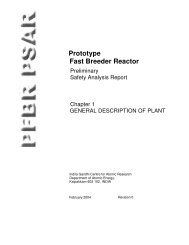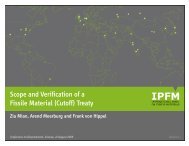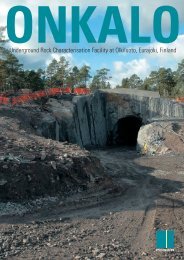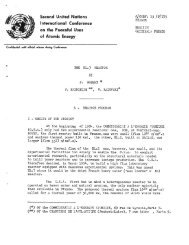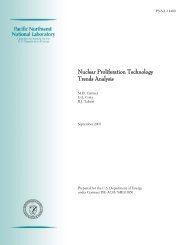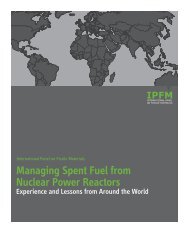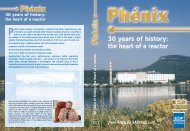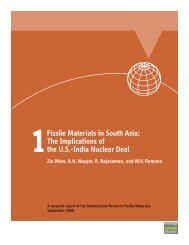A Fissile Material (Cutoff) Treaty and its Verification - International ...
A Fissile Material (Cutoff) Treaty and its Verification - International ...
A Fissile Material (Cutoff) Treaty and its Verification - International ...
Create successful ePaper yourself
Turn your PDF publications into a flip-book with our unique Google optimized e-Paper software.
What Are <strong>Fissile</strong> <strong>Material</strong>s?<strong>Material</strong> that can sustain an explosive fission chain reactionnotably highly enriched uranium (> 20% U-235) or plutonium (of almost any isotopic composition)Already some controversyRussia has proposed to limit FMCT to “weapon-grade” rather than “weapon-usable” uranium <strong>and</strong> plutoniumPlutonium containing more than 95% plutonium-239Uranium containing more than 90% uranium-235(but India tested with reactor-grade plutonium)(but Hiroshima bomb contained 80% uranium-235)A <strong>Fissile</strong> <strong>Material</strong> (<strong>Cutoff</strong>) <strong>Treaty</strong> <strong>and</strong> <strong>its</strong> <strong>Verification</strong> - Geneva, May 2, 2008
Highly Enriched Uranium StockpilesMetric tonsStockpile available for weaponsNaval (fresh)Naval (irradiated fuel)Civilian materialExcess (mostly for blend-down)Data for Russiahighly uncertain±300 MT173 MT(Apr 08)50 MT*30 MT**Estimate1,000750100 MT*590 MT*146 MT30 MT500100 MT128 MT2506.4 MT 1.5 MT250 MT0China France India Pakistan Russia U.K. United States NNW States20 MT* 30 MT*0.2 MT* 1.4 MT* 21.9 MT10 MT(250 MT of HEU are equivalent to 10,000 nuclear weapons)Revised:28 April 2008A <strong>Fissile</strong> <strong>Material</strong> (<strong>Cutoff</strong>) <strong>Treaty</strong> <strong>and</strong> <strong>its</strong> <strong>Verification</strong> - Geneva, May 2, 2008
Global Stocks of PlutoniumMetric tons200Military stockpileAdditional strategic stockpileExcess military material42.4 MT*Estimate150Civilian stockpile, stored in country (Jan. 2007)Civilian stockpile, stored outside country (Jan. 2007)50 MT10050Estimates of military stocksfor China, France, <strong>and</strong> India uncertain(±20%)Data for Russiahighly uncertain±25 MT95 MT*0.9 MT80.4 MT53.9 MT052.4 MT0.4 MT5.4 MT*38.0 MT38 MT4.4 MT12 MTBelgium China France Germany India Israel Japan North Korea Pakistan Russia U.K. United States3.3 MT 4 MT* 5 MT* 1 MT 0.65 MT* 0.45 MT* 6.7 MT 0.024 MT 0.08 MT*3.5 MT(50 MT of plutonium are equivalent to more than 10,000 nuclear weapons)Revised:28 April 2008A <strong>Fissile</strong> <strong>Material</strong> (<strong>Cutoff</strong>) <strong>Treaty</strong> <strong>and</strong> <strong>its</strong> <strong>Verification</strong> - Geneva, May 2, 2008
A <strong>Fissile</strong> <strong>Material</strong> (<strong>Cutoff</strong>) <strong>Treaty</strong> <strong>and</strong> <strong>its</strong> <strong>Verification</strong>Progress Report from the <strong>International</strong> Panel on <strong>Fissile</strong> <strong>Material</strong>s
FISSBAN SANS “C”A SOUTH AFRICANPERSPECTIVEby Jean du PreezDirector, <strong>International</strong> Organizations <strong>and</strong> Nonproliferation ProgramJames Martin Center for Nonproliferation StudiesMonterey Institute of <strong>International</strong> Studies1
UNDERSTANDING PRETORIA’SPOSITION: FMCT vs. FMTUnique practical experience Built & dismantled NW program IAEA verified completeness of stocks declaration Largest (former) military stockpile of weapons grade HEU outside theweapon statesRole in “Shannon M<strong>and</strong>ate” “negotiate a non-discriminatory, multilateral <strong>and</strong> internationally <strong>and</strong>effectively verifiable treaty banning the production of fissile materialfor nuclear weapons or other nuclear explosive devices.” SA argued that FMT should not only cap production but should alsocover existing stockpiles 1995 Shannon Report did not preclude any delegation from raisingthe issues of scope <strong>and</strong> verification within the Committee Necessary to get consensus in time for ‘95 NPT RevExtCon2
SECURING AN INDEFINATEDEALU.S. promise linked to NPT indefinite extensionCentral element of 1995 package of integral decisions:P&O disarmament action plan called for “immediate commencement <strong>and</strong>early conclusion of negotiations” of a fissile material treaty in accordancewith the Shannon Report <strong>and</strong> “the m<strong>and</strong>ate contained therein”At 2000 RevCon SA argued:to be an effective disarmament measure, treaty should have both nuclearnonproliferation <strong>and</strong> nuclear disarmament objectives“cut-off” treaty would only freeze status quo of nuclear capable countries,not reduce nuclear weapons over time Key among 13 practical steps adopted in 2000:Step 3: Conclusion within 5yrs of negotiations “in accordance with thestatement of the Special Coordinator in 1995 <strong>and</strong> the m<strong>and</strong>ate containedtherein, taking into consideration both nuclear disarmament <strong>and</strong> nuclearnon-proliferation objectives.”Also related to principle of irreversibility (step 5); unequivocal undertaking(step 6); IAEA Trilateral Initiative (step 8) & transparency (step 9b)3
ROLE IN CD/NPT One of the 1 st to put forward concrete proposals (2002working paper): Mer<strong>its</strong> of a verifiable treaty that should cover both past <strong>and</strong> futureproduction of weapons usable fissile material Emphasized that since declaration of weapons materials stocks byall nuclear-capable states would not be feasible, materialsdeclared as excess should be included as a starting point Stressed that a fissile material ban should not underminecommercial nuclear energy programsMore recent statements show that South Africa has not movedaway from this position US draft treaty seems to have further fueled SA arguments infavour of a verifiable nonproliferation & disarmament mechanism.“South Africa continues to support the placing by all thenuclear-weapon States of fissile material no longer requiredfor military purposes under international verification by theIAEA.” – Amb. Abdul S. Minty at the 2007 PrepCom4
AN OLD POLICY WITH A TWISTLinkage to efforts to reduce eliminate HEU for peaceful civilian purposesCommercial value of 400+kg former weapons grade HEU (isotope production, fuelfor partially converted research reactor, etc)Strategic value given nature of HEU removed from warheads <strong>and</strong> relevance toexcess military material stocksAt 2006 Oslo <strong>International</strong> Symposium on HEU a clear linkage was madebetween the need to minimise/eliminate civilian HEU & material declared asexcess in military stockpiles:“we cannot exclusively focus on HEU without similar attention being given toother materials used in the production of nuclear weapons, including plutonium,tritium <strong>and</strong> other transuranic elements that have a proliferation potential”“for any (FMT) to be considered as a disarmament measure, it would need toaddress, at the very least, the issue of excess stocks – that is, weapons materialdeclared as excess, as part of an ongoing <strong>and</strong> irreversible process of the verifiedelimination of all fissile material for nuclear weapons or other nuclear explosivedevices”“Such a <strong>Treaty</strong> can also prevent altogether or regulate the further production ofweapons-grade materials for legitimate <strong>and</strong> non-proscribed uses, including for thefueling of research reactors <strong>and</strong> naval reactors”- Amb. Abdul S. Minty5
FMT OBJECTIVES:A SOUTH AFRICAN PERSPECTIVENonproliferation:Disarmament:Prevent altogether or regulate further production of weapons-gradematerials for legitimate (non-proscribed) uses such as fuel for researchreactors, naval reactors, etc.Prohibit the transfer of previously-produced fissile material betweenweapon states for weapon purposes.Capture irreversibly weapons material declared as excess in ongoingprocess.Prohibit use in weapons of previously-produced fissile materials in use fornon-military purposes; in a weapon-production complex but declared to beexcess to military needs, <strong>and</strong> in a reserve for future use as fuel in military(e.g. naval-propulsion) reactors.Safety& Security:<strong>International</strong> monitoring of civilian fissile materials <strong>and</strong> weapons materialdeclared as excess in all countries would aid in securing these materialsagainst diversion to non-state actors.<strong>Verification</strong>:Must provide verified assurances that fissile material for weapons purposesis no longer produced6
CAPTURING FISSILEMATERIAL STOCKSCeasing production of weapons fissile material willquantitatively cap # of weapons & lay foundation for eventualeliminationAll nuclear materials in NNWS already subject to CSAs - NWS& de facto possessors will be affected by the inclusion ofexisting stocks, making it a disarmament mechanism If not, stockpiles material originating from dismantled weaponscould potentially be reversed into new weapon systems Reductions will only be irreversible if (re)use of fissile materialtransferred from military use to civilian nuclear activities (declaredas excess) is prohibitedPolitical & practical reasons why full/complete declaration ofall past produced weapons grade material as a Fissbanrequirement would be problematic Inability to verify the declaration of nuclear material in weaponswill not contribute to confidence building7
A NONPROLIFERATION &DISARMANT FISSBANA treaty that covers existing stocks would: Meet the objectives of Art VI, particularly in terms oftransparency, accountability, <strong>and</strong> irreversibility Further enhance nonproliferation objectives by preventingtransfers from NWS or de facto nuclear weapons possessorsto any NNWS Be “non-discriminatory” & equalize safeguards burden Avoid a potential loophole for declaring military fissilematerial produced after treaty’s entry into force as paststocks Would help prevent diversion of materials to non-stateactors8
A PRACTICAL & PRAGMATICAPPROACH<strong>Material</strong> declared as excess should be included in a starting inventory of astate upon E.I.F. <strong>and</strong> be subject to verification - add. excess materialwould be added to the starting inventory in an irreversible waywithout obligation to declare "completeness <strong>and</strong> correctness" of historicalproductionSome excess material in sensitive geometrical or compositional formswould rule out direct verification IAEA Trilateral Initiative provides a modelDeclared excess materials reworked into insensitive forms can beintroduced into the verification system as new materialDowngrade HEU or used for production of MOX fuel as the need arisesPu could be mixed with high-level radioactive waste for direct disposal.Rest of material stored under normal verification conditionsLack of agreement on scope should not stall negotiations until such timeas agreement is reachedShould be addressed during negotiations, in the same manner as other aspectsof the treaty9
TREATY VERIFICATIONPosition based on 3 basic principles:Notion that effective FMT verification cannot beachieved implies that the NPT is not verifiableSuccess & future credibility of an FMT would requireverified assurances that fissile material is no longerbeing produced for weapons purposesSubjecting NWS & 3 de-facto possessors tointernational monitoring of at least their civilian nuclearactivities would redress long-st<strong>and</strong>ing concern thatnuclear industries in NNWS are disadvantaged10
VERIFICATION SYSTEMSet of legally binding agreements between each party <strong>and</strong>the designated verification entityidentical for all parties, but modified to reflect restrictions required byNWSlimited to fissile material subject to the treaty rather than all nuclearmaterialDeclarations within a specific timeframe of all materialcovered under the treaty upon E.I.F.Declarations should trigger inspections of decommissioned.production <strong>and</strong> (if appropriate) storage facilities Should require some form of verifiable declaration that naval fuelis not diverted to nuclear-weapon purposes<strong>Material</strong> declared as excess, but still in sensitive geometrical& compositional forms should be subject to appropriateverification measures <strong>Material</strong>s re-worked into non-sensitive forms, should be placedunder appropriate IAEA safeguards11
VERIFICATION SYSTEM (cont.) IAEA most logical verification entity - wouldrequire more inspectors & larger budget Non-compliance should be dealt with intimeframe consistent with threat A promptly convened Conference of State partieswould offer opportunities to consider allegations<strong>and</strong> response of the suspected noncompliant party(or parties) Conference should have plenipotentiary powersto:refer allegations to the UNSCrecommend other measures as appropriaterequire a report from the verification entity onprogress made towards compliance by anoncompliant State.12
CONCLUSIONWilling to start negotiations without preconditions. BUT Pretoria may consider that a treaty that does not effectively addressirreversible nuclear disarmament is not worth pursuing. Likely to become more critical of attempts to restrict civilian fuel cycle;uses of fissile material, including HEU; <strong>and</strong> to make the AP a m<strong>and</strong>atorycondition of supplyCrucial to keep all negotiating options open Attempts to preempt inclusions of stocks or to create a “partial FMT” willlikely result in further deadlockFocus of future FMT should remain military use fissile material <strong>and</strong> notcivilian material in any way or form - if not it is likely to come under fire byone of <strong>its</strong> strongest supporters:Increased global interest in nuclear fuel as a sustainable energy sourcePretoria may be highly sensitive to any obligations which would implyrestrictions on civilian fissile production facilities or stocks of fissile material Judging by projected energy needs, it is estimated that by 2015 to 2020,SA plans to have more than half of <strong>its</strong> electric-power needs satisfied bynuclear energy.13
A <strong>Fissile</strong> <strong>Material</strong> (<strong>Cutoff</strong>) <strong>Treaty</strong> <strong>and</strong> <strong>its</strong> <strong>Verification</strong>Progress Report from the <strong>International</strong> Panel on <strong>Fissile</strong> <strong>Material</strong>sGeneva, May 2, 2008 Revision 7
The FM(C)T <strong>and</strong> the SouthAsian Nuclear Buildup: IndiaM. V. RamanaCentre for Interdisciplinary Studies inEnvironment <strong>and</strong> DevelopmentIndia
Historical support for FMCT Co-sponsored United Nations GeneralAssembly resolution 48/75L in 1993 Support reiterated after Conferenceon Disarmament (CD) adoptednegotiating m<strong>and</strong>ate in 1995 And in 1998 following establishmentof negotiating committee
Requirements No moratorium on production of fissilematerial Non discriminatory, multilaterally negotiated<strong>and</strong> internationally verifiable FMCT Security interests have to be fully addressed No inclusion of stockpiles
Indo-US Nuclear Agreement Lays the ground for resumption ofinternational nuclear trade with Indiain return for India putting some of <strong>its</strong>reactors under IAEA safeguards Waiting for Indian government <strong>and</strong> IAEAto agree on safeguards, NSG approval,<strong>and</strong> US Congress vote
Separation Plan Nine reactors outside of safeguards, somethat will only be commissioned by 2010 Reprocessing plants outside of safeguards Large plutonium stockpile kept outside ofsafeguards, can be used in unsafeguardedbreeder reactor to produce weapon gradeplutonium Policy makers seem to be keen onmaintaining large fissile production capacityfor weapons purposes for many years
Unsafeguarded Production Capacity Prototype Fast Breeder (scheduledoperating date 2010) ~ 140 kg/y Heavy Water Reactors ~ 200 kg/y Capacity of plutonium production reactorsat 70 % efficiency ~ 30 kg/yZia Mian, A.H. Nayyar, R. Rajaraman <strong>and</strong> M.V.Ramana, "<strong>Fissile</strong> <strong>Material</strong>s in South Asia <strong>and</strong> theImplications of the US-India Nuclear Deal,"http://www.fissilematerials.org/ipfm/site_down/ipfmresearchreport01.pdf
At the same time… Nuclear doctrine claims “India shallpursue a doctrine of credibleminimum nuclear deterrence” Suggests that government is notinterested in pursuing a majorbuildup of nuclear weapons Problem: never defined minimum,which is qualified as a dynamicconcept => arsenal size can’t be fixed
Estimates <strong>and</strong> Projections Sufficient weapon grade plutoniumfor ~ 110 weapons (5 kg/weapon) Not clear how much of this is in theform of nuclear weapon p<strong>its</strong> “Credible minimum deterrence”requirement – analysts have come upwith figures as low as a dozen toseveral hundreds (300 – 400) Might need 5-10 years at least
Prognosis India’s fissile material buildup willprobably continue for a while Stockpile size is a site of conflict –different groups/analysts argue fordifferent sizes Global stockpile (weapons <strong>and</strong> fissilematerial) reductions would help thosearguing for smaller arsenal <strong>and</strong>earlier cessation of fissile production
A <strong>Fissile</strong> <strong>Material</strong> (<strong>Cutoff</strong>) <strong>Treaty</strong> <strong>and</strong> <strong>its</strong> <strong>Verification</strong>Progress Report from the <strong>International</strong> Panel on <strong>Fissile</strong> <strong>Material</strong>sGeneva, May 2, 2008 Revision 7
The FM(C)T <strong>and</strong> the South AsianNuclear Buildup - PakistanA. H. NayyarSustainable Development Policy Institute,Islamabad, Pakistan
Scope: production - past, present <strong>and</strong> future• Pakistan wants an FMT, not FMCT<strong>Treaty</strong> should cover stocks, not just ban production• “A cut-off in the manufacturing of fissile material must beaccompanied by a m<strong>and</strong>atory programme for the eliminationof asymmetries in the possession of fissile material stockpilesby various states. Such transfer of fissile material to safeguardsshould be made first by states with huge stockpiles, both in theglobal <strong>and</strong> regional context.”• “A fissile material treaty must provide a schedule for aprogressive transfer of existing stockpiles to civilian use <strong>and</strong>placing these stockpiles under safeguards so that theunsafeguarded stocks are equalized at the lowest levelpossible.”
Verifiable, Non-intrusive <strong>and</strong> Non-discriminatory• Pakistan wants verifiable treaty<strong>Verification</strong> should cover declarations <strong>and</strong> stocksNot too intrusiveNon-discriminatory - all subject to same st<strong>and</strong>ardof verificationHow can this be done while keeping secret the sizeof fissile material stock <strong>and</strong> the number of weapons“We will cross the bridge when we come to it”
Tagged to India• Position on FMT is dependent on India's nuclear capabilities:How many weapons, what kind, size/quality of stocks.• “Pakistan cannot allow India to once again destabilize thebalance of deterrence in future through asymmetry in the levelof stockpiles”,Significant asymmetry only if include India’sun-safeguarded power reactor plutonium stocks• Pakistan is not likely to sign or ratify an FMCT unless Indiadoes so at the same time• If stocks not addressed, Pakistan may not sign or ratify.
Response to the US-India Nuclear Deal•August 2007 National [Nuclear] Comm<strong>and</strong> Authority“the [US-India] agreement would have implications on strategicstability as it would enable India to produce significantquantities of fissile material <strong>and</strong> nuclear weapons from unsafeguardednuclear reactors… <strong>and</strong> expressed firm resolve tomeet the requirements of future credible minimum deterrence.”•Pakistan exp<strong>and</strong>ing <strong>its</strong> production capacityMore efficient centrifugesTwo additional production reactors,New reprocessing plant
A growing <strong>and</strong> costly nuclear complexWe have spent more in the past three years on the nuclear programthan in the previous thirty -- Pervez Musharraf, 2006Pakistan may have fissile material for 60-80 weapons <strong>and</strong> is making more
A <strong>Fissile</strong> <strong>Material</strong> (<strong>Cutoff</strong>) <strong>Treaty</strong> <strong>and</strong> <strong>its</strong> <strong>Verification</strong>Progress Report from the <strong>International</strong> Panel on <strong>Fissile</strong> <strong>Material</strong>sGeneva, May 2, 2008 Revision 7
Draft Elements of a <strong>Fissile</strong> <strong>Material</strong>(Cut-off) <strong>Treaty</strong>FM(C)TThe <strong>International</strong> Panel on <strong>Fissile</strong> <strong>Material</strong>s isdeveloping draft elements for an FM(C)T.We plan to present these in more detail early 2009Presentation by Arend J. Meerburg, The Netherl<strong>and</strong>sComments are welcome: arendmeerburg@xs4all.nl1
Design Recommendations for an FM(C)T Should be verified (1993 General Assembly/ 2000 NPT ReviewConf.) By the IAEA (already trained <strong>and</strong> equipped to do the task) Unlike the CWC <strong>and</strong> CTBT, but like the NPT, no detailed verificationprovisions in the <strong>Treaty</strong> <strong>its</strong>elf since the IAEA has the mechanisms todevelop the special verification measures <strong>and</strong> safeguards neededfor an FM(C)T2
Scope The <strong>Treaty</strong> should, of course, prohibit the production of all fissilematerials (plutonium Pu, highly enriched uranium HEU) for use innuclear weapons Production facilities should be closed <strong>and</strong> dismantled or only beused for civilian or non-explosive purposes. This should be verified.Production facilities are reprocessing plants (separating Pu fromspent radioactive fuel) <strong>and</strong> uranium enrichment facilities. The FM(C)T should require that all civilian stocks of fissilematerials <strong>and</strong> stocks declared excess for weapons purposes not beused for weapons <strong>and</strong> therefore be safeguarded. Verifying only nonproductionwould not be enough! Could include verified commitments that fissile material to beused for non-weapon military purposes (e.g. naval fuel) not beused for weapons.3
A Conference of States Parties(CSP) Since the IAEA Board of Governors must report to the SecurityCouncil in the case of a safeguards-violation <strong>and</strong> a State with vetopower in the Security Council could be involved, a CSP may beneeded to h<strong>and</strong>le such a case (see also CWC <strong>and</strong> CTBT) The CSP may have <strong>its</strong> own Executive Committee, consisting ofmembers of the Board that are FM(C)T parties as well as a fewother parties.4
Entry into Force (EiF) An FM(C)T is particularly relevant for those 8 or 9 States active inthe nuclear field that do not have a safeguards agreement coveringall their nuclear materials. In view of the great differences between these States it would not bewise to dem<strong>and</strong> ratification by all those States before EiF ispossible. Better to start with the <strong>Treaty</strong> quickly <strong>and</strong> get experiencewith the application of the extended safeguards, <strong>and</strong> have a seriousreview after, say, ten years.5
A <strong>Fissile</strong> <strong>Material</strong> (<strong>Cutoff</strong>) <strong>Treaty</strong> <strong>and</strong> <strong>its</strong> <strong>Verification</strong>Progress Report from the <strong>International</strong> Panel on <strong>Fissile</strong> <strong>Material</strong>sGeneva, May 2, 2008 Revision 7
The <strong>Verification</strong> Challenge“ ‘Effective verification’ of an FMCT cannot be achieved … evenwith … verification mechanisms <strong>and</strong> provisions … so extensivethat they could compromise the core national securityinterests of key signatories, <strong>and</strong> so costly that many countrieswill be hesitant to accept them.”Bush Administration at Conference on Disarmament, May 17, 2006But the FMCT would require of the weapon states the same thingthat the IAEA is supposed to verify in NPT non-weapon statesA <strong>Fissile</strong> <strong>Material</strong> (<strong>Cutoff</strong>) <strong>Treaty</strong> <strong>and</strong> <strong>its</strong> <strong>Verification</strong> - Geneva, May 2, 2008
Five <strong>Verification</strong> Challengesin Nuclear Weapon States1. Shutdown status of enrichment & reprocessing plants2. No undeclared enrichment or reprocessing in military nuclear facilities3. Non-diversion of plutonium at previously operating reprocessing plants(not designed for safeguards <strong>and</strong> without verified design information)4. Non-production of HEU at previously operating enrichment plants5. Non-diversion of material declared excess for weapons purposes(plutonium <strong>and</strong> HEU in classified form, <strong>and</strong> HEU to be used as naval fuel)Minimizing additional IAEA Safeguards costsA <strong>Fissile</strong> <strong>Material</strong> (<strong>Cutoff</strong>) <strong>Treaty</strong> <strong>and</strong> <strong>its</strong> <strong>Verification</strong> - Geneva, May 2, 2008
Challenge #1Verifying Shutdown ofEnrichment <strong>and</strong> Reprocessing Plants• Satellite monitoring• Remotely monitored video cameras <strong>and</strong>sensors <strong>and</strong> seals on key equipment• Short-notice r<strong>and</strong>om inspectionsCost would not be highPotential sensitivities aboutqualitative indicators of past production(e.g. HEU <strong>and</strong> plutonium isotopics)The U.S. Portsmouth gaseous-diffusion uranium-enrichment plantstopped operating in 2001, but has not yet been decommissionedA <strong>Fissile</strong> <strong>Material</strong> (<strong>Cutoff</strong>) <strong>Treaty</strong> <strong>and</strong> <strong>its</strong> <strong>Verification</strong> - Geneva, May 2, 2008
Challenge #2Managed Access(to confirm no undeclared enrichment or reprocessing in military nuclear facilities)Managed-access procedures have been developed for OPCW inspectionsU.S. DOE has instructed <strong>its</strong> facilities <strong>and</strong> U.S. NRC has instructed <strong>its</strong> licenseesto prepare for managed access in connection with possible IAEA questions about thecompleteness <strong>and</strong> accuracy of U.S. Additional Protocol declarationsIPFM has been examining how managed access could be used to verify FM(C)TA <strong>Fissile</strong> <strong>Material</strong> (<strong>Cutoff</strong>) <strong>Treaty</strong> <strong>and</strong> <strong>its</strong> <strong>Verification</strong> - Geneva, May 2, 2008
Safeguards in Nuclear Weapon States TodayEnrichment <strong>and</strong> Reprocessing Facilities(operational or under construction)World total:Nuclear weapon states, total:Nuclear weapon states, safeguarded:*safeguarded or (to be) offered for safeguardsMany reprocessing <strong>and</strong> enrichment plants in the nuclear weapon statesalready are subject to international safeguards (Global <strong>Fissile</strong> <strong>Material</strong> Report 2007)*352812A <strong>Fissile</strong> <strong>Material</strong> (<strong>Cutoff</strong>) <strong>Treaty</strong> <strong>and</strong> <strong>its</strong> <strong>Verification</strong> - Geneva, May 2, 2008
Challenge #3Non-Diversion at OperatingReprocessing PlantsDesign information cannot be verified for operating unsafeguarded facilitiesBy far, most costly facilities to safeguardCountry Facility Safeguards StatusFrance UP2/UP3 Yes (Euratom)India Trombay/Tarapur/Kalpakkam NoJapan Tokai/Rokkasho YesRussia Mayak NoUnited Kingdom B205/Thorp Yes (Euratom)United States Savannah River NoCapacity [tons/yr]1000/100050/100/100210/8004001500/90015Measure plutonium flow at strategic points <strong>and</strong> r<strong>and</strong>om short-notice inspectionsAnnual cleanout <strong>and</strong> inventory$20 million investment <strong>and</strong> $1 million/plant-year. Much less costly than Rokkasho safeguardsbecause no resident inspectors <strong>and</strong> no on-site safeguards laboratoryA <strong>Fissile</strong> <strong>Material</strong> (<strong>Cutoff</strong>) <strong>Treaty</strong> <strong>and</strong> <strong>its</strong> <strong>Verification</strong> - Geneva, May 2, 2008
Challenge #4Centrifuge Enrichment Facilities(as currently expected for the year 2015)Country Facility Safeguards Status Capacity [tSWU/yr]Non-weaponstatesWeapon statesBrazil Resende YesGermany Gronau Yes (IAEA/Euratom)Iran Natanz YesJapan Rokkasho YesThe Netherl<strong>and</strong>s Almelo Yes (IAEA/Euratom)France George Besse II Yes (IAEA/Euratom)U.K. Capenhurst Yes (IAEA/Euratom)Piketon, OhioLikelyUnited StatesEunice, NMPossibleTBD (Areva)PossibleChinaShaanxiYes (IAEA)Lanzhou IIOffered?RussiaAngarsk IIOffered?4 others NoIndia Rattehalli NoPakistan Kahuta No1204,500250*1,0503,5007,5004,0003,5003,0003,0005005005,000*30,000*4-1015-20*uncertain valuesA <strong>Fissile</strong> <strong>Material</strong> (<strong>Cutoff</strong>) <strong>Treaty</strong> <strong>and</strong> <strong>its</strong> <strong>Verification</strong> - Geneva, May 2, 2008
Novouralsk, Russia
Challenge #4Verifying Non-Production of HEU inPreviously Operating Enrichment FacilitiesInstallation/use of continuous (or portable) enrichment monitorsAlready added to centrifuge facilities in the United Kingdom <strong>and</strong> in ChinaSwipe sampling techniques to detect HEU particlesImages of micron-sized uranium particlesmade with a Secondary Ion Mass SpectrometerLeft:Right:U-235 ConcentrationU-238 ConcentrationPre-FM(C)T HEU particles may be identified with age-dating techniques (<strong>and</strong> isotopic analysis)A <strong>Fissile</strong> <strong>Material</strong> (<strong>Cutoff</strong>) <strong>Treaty</strong> <strong>and</strong> <strong>its</strong> <strong>Verification</strong> - Geneva, May 2, 2008
Challenge #5Verifying Non-Diversion of <strong>Material</strong>Declared Excess for Weapon Purposes(while in classified form)plutonium ?more than 2 kg ?weapon-grade ?“Attribute <strong>Verification</strong> System” (AVNG)incl. Neutron <strong>and</strong> Gamma Detector1996-2002 Trilateral Initiative developedapproach to determine that a container holdsmore than a threshold amount of weapongradeplutoniumContainer withclassified plutoniumcomponentResults communicated by red or green lightsthrough information barrierIPFM is working on corresponding approachfor HEU componentsA <strong>Fissile</strong> <strong>Material</strong> (<strong>Cutoff</strong>) <strong>Treaty</strong> <strong>and</strong> <strong>its</strong> <strong>Verification</strong> - Geneva, May 2, 2008
Challenge #5HEU Stockpiles for Naval FuelSSN-774 Virginia-class (NSSN New Attack Submarine)Source: U.S. NavyThe United States, Russia, <strong>and</strong> the United Kingdom use HEU to fuel naval vessels(mostly submarines; the U.S. <strong>and</strong> U.K. vessels are fueled with weapon-grade uranium)The U.S. fleet currently requires about 2000 kg of weapon-grade uranium per yearThe United States has reserved 128 tons of excess weapon-grade uranium(enough for 5,000 nuclear weapons) for future use in naval reactorsA <strong>Fissile</strong> <strong>Material</strong> (<strong>Cutoff</strong>) <strong>Treaty</strong> <strong>and</strong> <strong>its</strong> <strong>Verification</strong> - Geneva, May 2, 2008
Challenge #5Non-Diversion of HEU Set AsideFor Naval (<strong>and</strong> Tritium Production) ReactorsMonitored HEU stockpileFuel fabrication facilityDeclared quantity of HEU metered outto fuel-fabrication facilityContainer holdingfabricated reactor coreInstallation of fuelin propulsion reactorAmount of HEU in fabricated fuelverified from outside container throughinformation barrierInstallation in reactor might beverified non-intrusivelyA <strong>Fissile</strong> <strong>Material</strong> (<strong>Cutoff</strong>) <strong>Treaty</strong> <strong>and</strong> <strong>its</strong> <strong>Verification</strong> - Geneva, May 2, 2008
ConclusionThe technical challenges of FM(C)T verification are significantbut probably not as significant asthe political challenges of FM(C)T negotiationThe costs of FM(C)T verification could beless than the current IAEA safeguards budgetThe technical challenges <strong>and</strong> costs will come downas former military production facilities areshut down <strong>and</strong> dismantledA <strong>Fissile</strong> <strong>Material</strong> (<strong>Cutoff</strong>) <strong>Treaty</strong> <strong>and</strong> <strong>its</strong> <strong>Verification</strong> - Geneva, May 2, 2008
A <strong>Fissile</strong> <strong>Material</strong> (<strong>Cutoff</strong>) <strong>Treaty</strong> <strong>and</strong> <strong>its</strong> <strong>Verification</strong>Progress Report from the <strong>International</strong> Panel on <strong>Fissile</strong> <strong>Material</strong>s



